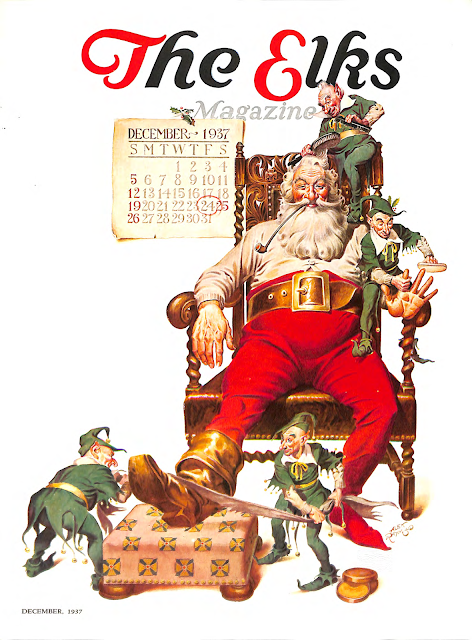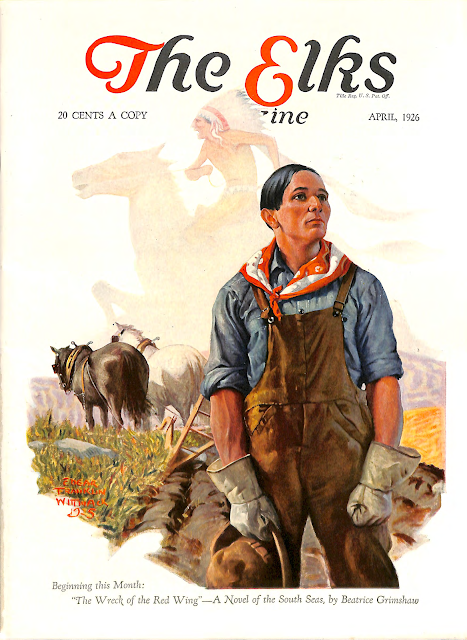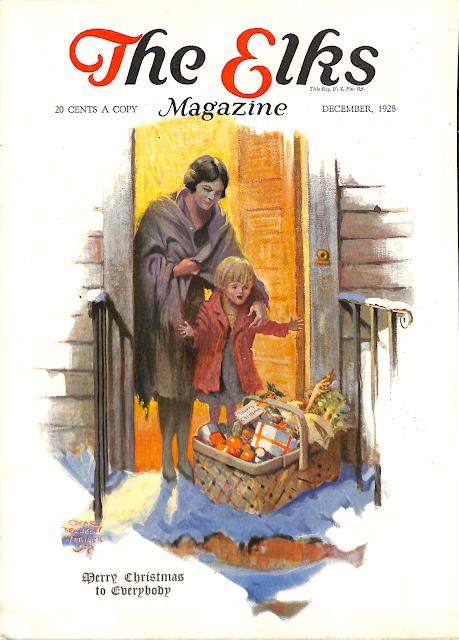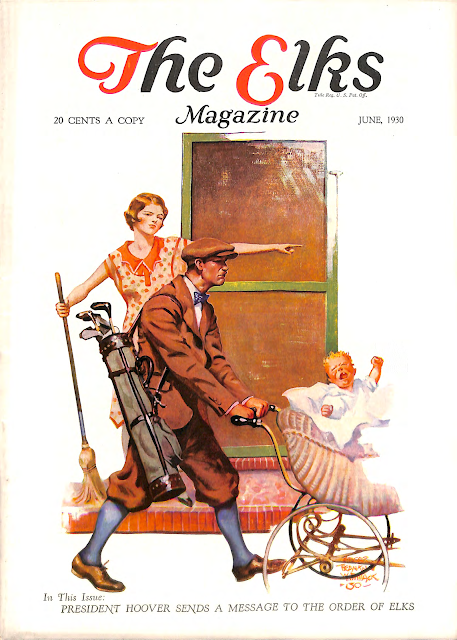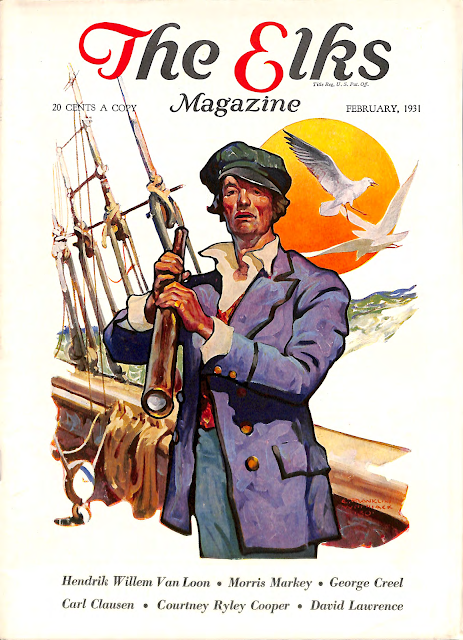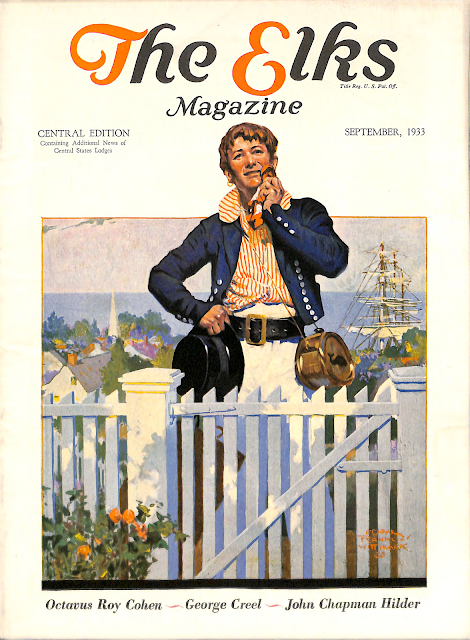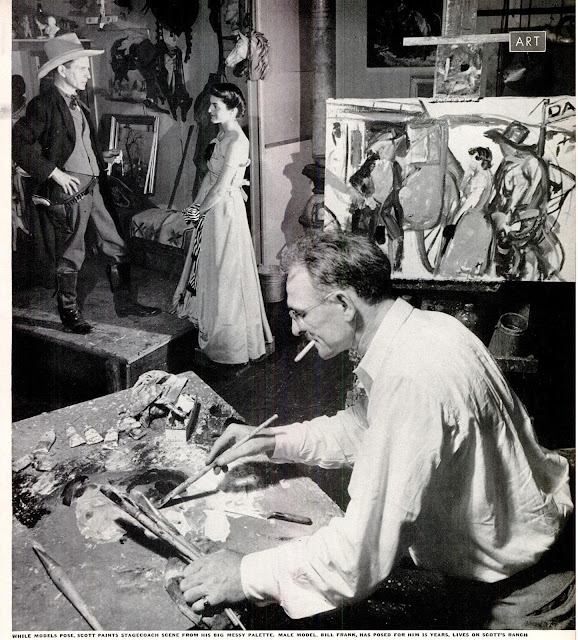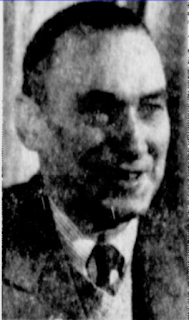 |
| Thomas A. Curry aka Tom Curry, Author |
Tom Curry, a long-time Norwalk resident, sold his first fiction story at 20 while studying chemical engineering at Columbia College in 1920, and within a year’s time the talented young student was writing for a half-dozen of the more popular "pulp” magazines—mainly Western fiction. And for over 50 years, bold, fearless heroes who virtually sprung to life in the thrilling pages of his stories— such as the Rio Kid and his horse, Saber, who rode the dangerous frontier trails in search of ruthless outlaws and evil doers; Walt Slade, whose iron fists and blazing six-shooter spread terror among the toughest badmen; courageous Texas Rangers, hard-riding, fast-shooting men, ever ready to face any outlaw’s vengeance in patrolling the dangerous border area between Texas and Mexico; Ranger Riders, super-heroes of the early West, among them many of the toughest, roughest, most memorable characters who ever roamed the frontier, men who had to ride hard and shoot fast and straight in order to survive; and many others who gambled their lives in the winning of the West, back in the legendary era following the Civil War, when the Plains Indians, said to have been the world’s greatest horsemen, donned their war paint to hunt the white-skinned invader—have thrilled his many readers.
For a half-century the well-known local author has been steadily contributing to the "pulps, ” turning out between 500, 000 and 600, 000 words a year regularly. He has sold all types of stories—including detective, sports, adventure, fantasy, science—you name it, he has written it. He has also appeared in magazines such as Collier’s, American Home, The Elks, St. Nicholas, The American, McClure’s, and many others, literally hundreds of periodicals. Several hundred hardcover and paperback books have appeared under his byline and under several of his pen names (such as "Jackson Cole” and "Bradford Scott") for professional purposes. In his career Mr. Curry would often have three or four hardcover or paperback books, or a half-dozen or more full-length stories in pulp magazines, appearing in print under three or four different names, in the same month. But his real signature, Tom Curry, appears on the majority of his more than 175 novels and countless hundreds of magazine feature stories.
Born in Hartford on Nov. 4, 1900, Mr. Curry has resided in the Cranbury section of Norwalk for most of the past 50 years. He and his wife, the former Louise Moore of New York city, live in one of Norwalk’s oldest houses a big, attractive Colonial farmhouse with hand-hewn chestnut beams and a large, old-fashioned fireplace with a Dutch oven.
At Columbia, Mr. Curry was a member of the varsity water-polo team and he has never lost his love of swimming, spending almost every summer afternoon at the beach. For 20 years he played tennis during the summer months, and during those two decades was equally well-known on Norwalk and Westport tennis courts as a star competitor. In fact, back in the 1930s, he and Bob Carse, who was also a well-known local fiction writer, after winning practically every tournament in the county, climaxed the season by taking the men’s doubles championship in the Nassau Invitation Tennis Tournament. During the winter months, Mr. Curry performed on the badminton courts—also being of championship ranking at that sport. Now he is playing ping-pong, a game at which he also excels.
As a young boy, Mr. Curry was virtually surrounded by successful writers in his family. In 1914 his father sold what turned out to be a profitable ploy, "Just The Same As Now, " to David Belasco, the famed producer, Mr. Curry’s mother also was a noted playwright, and his sister was married to a noted author, F. R. Buckley.
"My brother-in-law had never been west of Philadelphia in his life, but he wrote some of the best Western stories, some of the greatest action fiction I've ever read. One, 'Gold Mounted Guns’, won the 1922 O' Henry prize and is included in many anthologies and textbooks. For years he was a regular contributor to Western Story and other top pulp magazines.
"With all these shining examples to inspire me, I decided to try my own hand at fiction-writing, and was fortunate to have it accepted by A. L. Sessions, editor of People’s, one of the Street & Smith's numerous pulps. He sent me $25 and I was naturally puffed with pride. "
Mr. Curry studied chemical engineering at Columbia for three years. Then, at 23, he accepted a job as crime reporter-working from 6 P. M. to 3 A. M. —for the old New York American.
"I got to know a number of police detectives, often accompanying them when they went out to make investigations or arrests, " he reflected. "It was on a first name basis with practically every cop on the night- shift boats. It was heady stuff for a youth, constantly making the rounds of the various police precincts, but I soon quit. "
"I felt I was a free-lance writer at heart and wanted more. " "During the 1920s the fiction field was flourishing... vigorously thriving... with a steady, ever-flowing source of material that was being readily consumed by dozens of publishers, both hardcover, paperback and magazine. I wrote a number of detective stories, and Black Mask Magazine bought one. Soon I became one of Editor Joe Shaw’s regular contributors, and my name began appearing in distinguished company—Dashiell Hammett and Erle Stanley Gardner being among the many authors writing for Shaw at the time. "
During the period when Mr. Curry covered the night-beat as a police reporter on the old New York American, he saw firsthand the incessant flow of daily life that comprises a great metropolis such as New York city, and from his vast experience gained in accompanying detectives and policemen on their various nightly assignments, he acquired invaluable knowledge that gave him the background to successfully produce hundreds of detective fiction stories for numerous pulp magazines during the 1920s and 1930s. During that "Golden era” for fiction-writers, he also sold hundreds of action-packed Western stories, historical articles and short stories.
For several years after leaving the N. Y. American, Mr. Curry and his wife traveled extensively throughout the Western United States as well as in a number of foreign countries before settling for six months in Bermuda, "living in a coral cottage by the sea. ” Known by his many publishers as a talented, dependable, prolific author, his stories, compiling an amazing total of over 500, 000 words a year, were readily accepted.
"During that lucrative period... an era that is frequently called the 'Golden Age' of the magazine... when it seemed almost impossible not to sell a story... new magazines popped up almost every week and In a short time had a circulation of 250, 000 or above. It seemed fantastic, but there were so many pulps and smooth-paper periodicals you could scarcely keep track of them all. Incredible numbers of stories were required, and editors couldn’t be too picky. It was truly a writer's paradise! "
And Mr. Curry successfully wrote for a great number of publications. He branched out, with his byline appearing as often in the smooth-paper magazines as it did in the pulps—among them being Argosy, G-Men, Thrilling Adventure, Blue Book, Black Mask, Popular Western, Detective Fiction, as well as the Rio Kid Western, Thrilling Western, Range Riders, Texas Rangers and numerous others.
Many of these weekly or monthly Western publications confined their stories to the period following the American Civil War, during the time when real historical characters such as Wyatt Earp, Buffalo Bill, General Custer, Calamity Jane, Bat Masterson, Bill Hickock, Quanah Parker, the Comanche Chief, and many others roamed the treacherous trials of the great Western frontier throughout New Mexico, Arizona, Nevada, Montana, Colorado, Texas, etc in The Rio Kid Western, for many years a popular historical Western publication owned and published by Thrilling Publications, whose chief editor was the famed Leo Margulies (who was a frequent visitor in Norwalk, his uncle at one time having owned and operated a business on Washington street). Thrilling Publications published some 50 periodicals - Westerns, Detective, mystery, all combat, spy, sports etc.
The Rio Kid was the hero of an exciting adventure in every monthly issue of the magazine named for him. An ex-cavalry officer who had served under General Custer, he constantly—as the brave young hero confronting the ruthless villain—came into contact with those other well-known heroes along the Western trails, and were relived.
For years Mr. Curry wrote fast-action thrillers involving the Rio Kid as well as the Texas Rangers. "The general theme must be that the hero, being young, handsome, strong, personable, and endowed with great moral courage and character, as well as being an expert shot, fist-fighter, cowpuncher and rider, must, in willingly facing the most hazardous missions, track down, confront and defeat the villain in violent physical combat. The outlaw, whose ruthless designs threaten the very existence of the hero and those he loves, is not only a dangerous killer but is equally as skilled both in handling a six-shooter and riding a horse. And the nerveless villain, with many notches in his blazing guns, who invariably has joined forces with other equally infamous renegades and notorious bad-men, must get his just due. The fearsome bandits and robber gangs, stealing the gold, rustling the cattle, or holding up the stage coach, must not be successful in escaping justice after having carried out their devious plans. And, like all romantic adventure stories, these yarns must have a happy ending, as far as the hero is concerned, that is. ”
Maintaining his tremendous deadline schedule keeps Mr. Curry constantly busy figuring out fresh, new "plots, ” always thinking, pondering, planning the motivating phases of action which fit into the basic outline of the story he is writing. Saying that he has always found writing to be a most pleasurable occupation, he explained that for many years he was able to turn out the finished manuscript of a full-length book or magazine story in the short period of but two to four weeks, working at his typewriter for five or six hours a day, seven days a week, including holidays.
And which of your many fictional heroes is your favorite character?
“One of my all-time favorites has to be the Rio Kid, ” he said. "Of course I'm very fond of all of them. "
In considering your sudden change of plans in regards to your life’s profession while a student at Columbia College, have you ever regretted it?
"No, absolutely not, " he admitted. "I've had a great many years of pleasure being a somewhat successful fiction writer, " he continued, "and I can honestly say that I'm very proud of having my name associated with the truly distinguished company of Western chroniclers and historians. "
Many of the novels that Mr. Curry has written remain in print today. And as each succeeding generation continues to find adventure and reading excitement in his numerous stories, the majority of which are thrilling Western yarns of fast-riding men with blazing guns, of lost mines and hidden treasures, invariably set in a background of purple sagebrush, blinding desert heal and dust, the reader can almost feel himself squinting into the bright crimson sunset. Exciting epics of fiery action, of great American heroes who gambled their lives in the winning of the West.
But what happened to the magazine publishing business when the Great Depression hit?
"It was a very difficult time... beginning about the mid-’30s. There was great rivalry for the writing dollar, and the pulp market had virtually collapsed... why, within the space of a few months' time even the best-selling magazines hit a low slump. The bottom literally fell out of the market. "
Mr. Curry has traveled extensively in and intimately knows the old West about which he writes. A top literary critic reviewing one of his Western novels for a New York newspaper in 1951 said, "You'll find in any Tom Curry western story a true picture of the West that was and is no more.”
Mr. Curry says he is especially proud of his "Famous Figures Of The Old West". This contains 60 short biographies of heroes and villains of the Western Frontier. The book is beautifully illustrated by Wood Cowan, a long time resident of Weston, who, as a member of Newspaper Enterprises of America (NEA), drew popular syndicated features for many years, one being the widely- distributed cartoon known as "Major Hoople. " "The Buffalo Hunters, " one of Mr. Curry’s best-known novels is being published as a paperback, and there are several new stories that will soon appear on the racks, some by "Jackson Cole" (Mr. Curry’s pen-name used by the publishers on all Curry novels appearing in Texas Rangers Magazine). From 1936 to 1950, Mr. Curry wrote 85 of these lead stories.
Recently he sold a "Walt Slade" Western, which will be under the byline, "Bradford Scott. " Walt Slade was created by Leslie Scott, a well-known writer and long-time close friend of Mr. Curry who has turned out some 100 of these paperback Westerns, for Pyramid Books.
In 1951, after the magazine market had collapsed ("Television had delivered the knockout punch to the general fiction field"), Mr. Curry accepted a position with Dorr-Olivcr, Inc., an engineering firm in Westport, and stayed with them for 14 years. In 1964 he again turned to free-lance writing full-time—Western novels plus articles on a variety of subjects. He was soon turning out some 500,000 words a year, mainly in hardcover and paperbacks and a few pulp magazines still remaining on the stands, though the latter market had changed drastically, with little fiction being used and articles being basically in demand.
Beside a number of fiction stories of Zane Grey Western Magazine, Mr. Curry also has recently sold several true historical pieces, one titled ". Secret of the Little Big Horn, " concerning Custer’s famous last stand, and a short biography of the famous author, Zane Grey.
Now, after 50 years of turning out a constant flow of novels, short stories, historical features and science articles, Mr. Curry says it is time that he "slowed down a bit. " He and his wife, who recently retired after 20 years with the Famous Schools in Westport, plan to head south this winter to escape the snow and cold. Mr. Curry has been a prominent member of Western Writers of America for half a century, and this past June, he and his wife attended the WWA convention held in Santa Fe, New Mexico, with many other well-known authors.
His current novel, "Gunfighter’s Holiday" (Avalon Books, 1971), may be found on local library shelves, while a second novel, "Colorado River Gold. " is scheduled for publication in December.
Mr. and Mrs. Curry have a son. Dr. Stephen J. Curry, who graduated from Norwalk High School, Columbia University, and the University of Wisconsin. He is a professor of English in a college in upstate New York. Mr. and Mrs. Curry also have a grandson, Geoffrey S., age 10.
For a half-century the well-known local author has been steadily contributing to the "pulps, ” turning out between 500, 000 and 600, 000 words a year regularly. He has sold all types of stories—including detective, sports, adventure, fantasy, science—you name it, he has written it. He has also appeared in magazines such as Collier’s, American Home, The Elks, St. Nicholas, The American, McClure’s, and many others, literally hundreds of periodicals. Several hundred hardcover and paperback books have appeared under his byline and under several of his pen names (such as "Jackson Cole” and "Bradford Scott") for professional purposes. In his career Mr. Curry would often have three or four hardcover or paperback books, or a half-dozen or more full-length stories in pulp magazines, appearing in print under three or four different names, in the same month. But his real signature, Tom Curry, appears on the majority of his more than 175 novels and countless hundreds of magazine feature stories.
Born in Hartford on Nov. 4, 1900, Mr. Curry has resided in the Cranbury section of Norwalk for most of the past 50 years. He and his wife, the former Louise Moore of New York city, live in one of Norwalk’s oldest houses a big, attractive Colonial farmhouse with hand-hewn chestnut beams and a large, old-fashioned fireplace with a Dutch oven.
At Columbia, Mr. Curry was a member of the varsity water-polo team and he has never lost his love of swimming, spending almost every summer afternoon at the beach. For 20 years he played tennis during the summer months, and during those two decades was equally well-known on Norwalk and Westport tennis courts as a star competitor. In fact, back in the 1930s, he and Bob Carse, who was also a well-known local fiction writer, after winning practically every tournament in the county, climaxed the season by taking the men’s doubles championship in the Nassau Invitation Tennis Tournament. During the winter months, Mr. Curry performed on the badminton courts—also being of championship ranking at that sport. Now he is playing ping-pong, a game at which he also excels.
As a young boy, Mr. Curry was virtually surrounded by successful writers in his family. In 1914 his father sold what turned out to be a profitable ploy, "Just The Same As Now, " to David Belasco, the famed producer, Mr. Curry’s mother also was a noted playwright, and his sister was married to a noted author, F. R. Buckley.
Pride Counts
"My brother-in-law had never been west of Philadelphia in his life, but he wrote some of the best Western stories, some of the greatest action fiction I've ever read. One, 'Gold Mounted Guns’, won the 1922 O' Henry prize and is included in many anthologies and textbooks. For years he was a regular contributor to Western Story and other top pulp magazines.
"With all these shining examples to inspire me, I decided to try my own hand at fiction-writing, and was fortunate to have it accepted by A. L. Sessions, editor of People’s, one of the Street & Smith's numerous pulps. He sent me $25 and I was naturally puffed with pride. "
Mr. Curry studied chemical engineering at Columbia for three years. Then, at 23, he accepted a job as crime reporter-working from 6 P. M. to 3 A. M. —for the old New York American.
"I got to know a number of police detectives, often accompanying them when they went out to make investigations or arrests, " he reflected. "It was on a first name basis with practically every cop on the night- shift boats. It was heady stuff for a youth, constantly making the rounds of the various police precincts, but I soon quit. "
"I felt I was a free-lance writer at heart and wanted more. " "During the 1920s the fiction field was flourishing... vigorously thriving... with a steady, ever-flowing source of material that was being readily consumed by dozens of publishers, both hardcover, paperback and magazine. I wrote a number of detective stories, and Black Mask Magazine bought one. Soon I became one of Editor Joe Shaw’s regular contributors, and my name began appearing in distinguished company—Dashiell Hammett and Erle Stanley Gardner being among the many authors writing for Shaw at the time. "
During the period when Mr. Curry covered the night-beat as a police reporter on the old New York American, he saw firsthand the incessant flow of daily life that comprises a great metropolis such as New York city, and from his vast experience gained in accompanying detectives and policemen on their various nightly assignments, he acquired invaluable knowledge that gave him the background to successfully produce hundreds of detective fiction stories for numerous pulp magazines during the 1920s and 1930s. During that "Golden era” for fiction-writers, he also sold hundreds of action-packed Western stories, historical articles and short stories.
Travels In West
For several years after leaving the N. Y. American, Mr. Curry and his wife traveled extensively throughout the Western United States as well as in a number of foreign countries before settling for six months in Bermuda, "living in a coral cottage by the sea. ” Known by his many publishers as a talented, dependable, prolific author, his stories, compiling an amazing total of over 500, 000 words a year, were readily accepted.
"During that lucrative period... an era that is frequently called the 'Golden Age' of the magazine... when it seemed almost impossible not to sell a story... new magazines popped up almost every week and In a short time had a circulation of 250, 000 or above. It seemed fantastic, but there were so many pulps and smooth-paper periodicals you could scarcely keep track of them all. Incredible numbers of stories were required, and editors couldn’t be too picky. It was truly a writer's paradise! "
And Mr. Curry successfully wrote for a great number of publications. He branched out, with his byline appearing as often in the smooth-paper magazines as it did in the pulps—among them being Argosy, G-Men, Thrilling Adventure, Blue Book, Black Mask, Popular Western, Detective Fiction, as well as the Rio Kid Western, Thrilling Western, Range Riders, Texas Rangers and numerous others.
Many of these weekly or monthly Western publications confined their stories to the period following the American Civil War, during the time when real historical characters such as Wyatt Earp, Buffalo Bill, General Custer, Calamity Jane, Bat Masterson, Bill Hickock, Quanah Parker, the Comanche Chief, and many others roamed the treacherous trials of the great Western frontier throughout New Mexico, Arizona, Nevada, Montana, Colorado, Texas, etc in The Rio Kid Western, for many years a popular historical Western publication owned and published by Thrilling Publications, whose chief editor was the famed Leo Margulies (who was a frequent visitor in Norwalk, his uncle at one time having owned and operated a business on Washington street). Thrilling Publications published some 50 periodicals - Westerns, Detective, mystery, all combat, spy, sports etc.
The Rio Kid was the hero of an exciting adventure in every monthly issue of the magazine named for him. An ex-cavalry officer who had served under General Custer, he constantly—as the brave young hero confronting the ruthless villain—came into contact with those other well-known heroes along the Western trails, and were relived.
The Rio Kid Thriller
For years Mr. Curry wrote fast-action thrillers involving the Rio Kid as well as the Texas Rangers. "The general theme must be that the hero, being young, handsome, strong, personable, and endowed with great moral courage and character, as well as being an expert shot, fist-fighter, cowpuncher and rider, must, in willingly facing the most hazardous missions, track down, confront and defeat the villain in violent physical combat. The outlaw, whose ruthless designs threaten the very existence of the hero and those he loves, is not only a dangerous killer but is equally as skilled both in handling a six-shooter and riding a horse. And the nerveless villain, with many notches in his blazing guns, who invariably has joined forces with other equally infamous renegades and notorious bad-men, must get his just due. The fearsome bandits and robber gangs, stealing the gold, rustling the cattle, or holding up the stage coach, must not be successful in escaping justice after having carried out their devious plans. And, like all romantic adventure stories, these yarns must have a happy ending, as far as the hero is concerned, that is. ”
Maintaining his tremendous deadline schedule keeps Mr. Curry constantly busy figuring out fresh, new "plots, ” always thinking, pondering, planning the motivating phases of action which fit into the basic outline of the story he is writing. Saying that he has always found writing to be a most pleasurable occupation, he explained that for many years he was able to turn out the finished manuscript of a full-length book or magazine story in the short period of but two to four weeks, working at his typewriter for five or six hours a day, seven days a week, including holidays.
And which of your many fictional heroes is your favorite character?
“One of my all-time favorites has to be the Rio Kid, ” he said. "Of course I'm very fond of all of them. "
In considering your sudden change of plans in regards to your life’s profession while a student at Columbia College, have you ever regretted it?
"No, absolutely not, " he admitted. "I've had a great many years of pleasure being a somewhat successful fiction writer, " he continued, "and I can honestly say that I'm very proud of having my name associated with the truly distinguished company of Western chroniclers and historians. "
Many of the novels that Mr. Curry has written remain in print today. And as each succeeding generation continues to find adventure and reading excitement in his numerous stories, the majority of which are thrilling Western yarns of fast-riding men with blazing guns, of lost mines and hidden treasures, invariably set in a background of purple sagebrush, blinding desert heal and dust, the reader can almost feel himself squinting into the bright crimson sunset. Exciting epics of fiery action, of great American heroes who gambled their lives in the winning of the West.
But what happened to the magazine publishing business when the Great Depression hit?
"It was a very difficult time... beginning about the mid-’30s. There was great rivalry for the writing dollar, and the pulp market had virtually collapsed... why, within the space of a few months' time even the best-selling magazines hit a low slump. The bottom literally fell out of the market. "
Mr. Curry has traveled extensively in and intimately knows the old West about which he writes. A top literary critic reviewing one of his Western novels for a New York newspaper in 1951 said, "You'll find in any Tom Curry western story a true picture of the West that was and is no more.”
Mr. Curry says he is especially proud of his "Famous Figures Of The Old West". This contains 60 short biographies of heroes and villains of the Western Frontier. The book is beautifully illustrated by Wood Cowan, a long time resident of Weston, who, as a member of Newspaper Enterprises of America (NEA), drew popular syndicated features for many years, one being the widely- distributed cartoon known as "Major Hoople. " "The Buffalo Hunters, " one of Mr. Curry’s best-known novels is being published as a paperback, and there are several new stories that will soon appear on the racks, some by "Jackson Cole" (Mr. Curry’s pen-name used by the publishers on all Curry novels appearing in Texas Rangers Magazine). From 1936 to 1950, Mr. Curry wrote 85 of these lead stories.
Recently he sold a "Walt Slade" Western, which will be under the byline, "Bradford Scott. " Walt Slade was created by Leslie Scott, a well-known writer and long-time close friend of Mr. Curry who has turned out some 100 of these paperback Westerns, for Pyramid Books.
In 1951, after the magazine market had collapsed ("Television had delivered the knockout punch to the general fiction field"), Mr. Curry accepted a position with Dorr-Olivcr, Inc., an engineering firm in Westport, and stayed with them for 14 years. In 1964 he again turned to free-lance writing full-time—Western novels plus articles on a variety of subjects. He was soon turning out some 500,000 words a year, mainly in hardcover and paperbacks and a few pulp magazines still remaining on the stands, though the latter market had changed drastically, with little fiction being used and articles being basically in demand.
Beside a number of fiction stories of Zane Grey Western Magazine, Mr. Curry also has recently sold several true historical pieces, one titled ". Secret of the Little Big Horn, " concerning Custer’s famous last stand, and a short biography of the famous author, Zane Grey.
Now, after 50 years of turning out a constant flow of novels, short stories, historical features and science articles, Mr. Curry says it is time that he "slowed down a bit. " He and his wife, who recently retired after 20 years with the Famous Schools in Westport, plan to head south this winter to escape the snow and cold. Mr. Curry has been a prominent member of Western Writers of America for half a century, and this past June, he and his wife attended the WWA convention held in Santa Fe, New Mexico, with many other well-known authors.
His current novel, "Gunfighter’s Holiday" (Avalon Books, 1971), may be found on local library shelves, while a second novel, "Colorado River Gold. " is scheduled for publication in December.
Mr. and Mrs. Curry have a son. Dr. Stephen J. Curry, who graduated from Norwalk High School, Columbia University, and the University of Wisconsin. He is a professor of English in a college in upstate New York. Mr. and Mrs. Curry also have a grandson, Geoffrey S., age 10.


